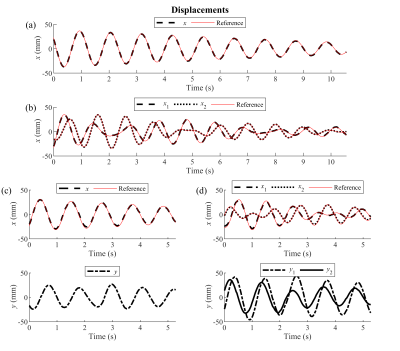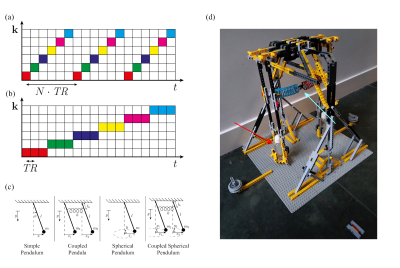Max H. C. van Riel1,2, Niek R. F. Huttinga1, and Alessandro Sbrizzi1
1Department of Radiotherapy, Computational Imaging Group for MR diagnostics and therapy, UMC Utrecht, Utrecht, Netherlands, 2Department of Biomedical Engineering, Medical Image Analysis, Eindhoven University of Technology, Eindhoven, Netherlands
1Department of Radiotherapy, Computational Imaging Group for MR diagnostics and therapy, UMC Utrecht, Utrecht, Netherlands, 2Department of Biomedical Engineering, Medical Image Analysis, Eindhoven University of Technology, Eindhoven, Netherlands
We propose
spectro-dynamic MRI as a method for the characterization of dynamical systems
directly from k-space data. A measurement model and dynamical model are used to
estimate the motion fields and dynamical parameters of the system at a
millisecond time scale from heavily undersampled data.

Figure 3: The
estimated displacements. The black lines indicate the estimated displacements
for the experiments with (a) a simple pendulum, (b) coupled pendula, (c) a
spherical pendulum, and (d) coupled spherical pendula. For the 2D acquisitions
in (c) and (d), the $$$x$$$- and $$$y$$$-displacements are plotted separately.
The red line is the reference line as determined in Fig. 2.

Figure 1: (a)
In conventional MRI, a different line in k-space is sampled every repetition. (b)
In spectro-dynamic MRI, one k-space line is repeated $$$N_\textrm{rep}$$$ times,
reducing the time interval between the acquisition of the same data point in
k-space. (c) Schematic representations of the four dynamical systems used for
our experiments. (d) The experimental setup with two pendula, each containing a
gel-filled vial (red arrow), which are connected with a spring (light blue
arrow).
